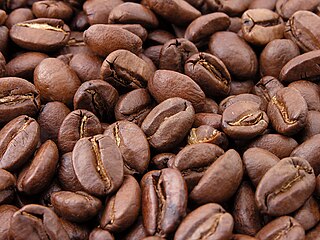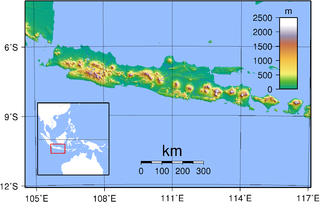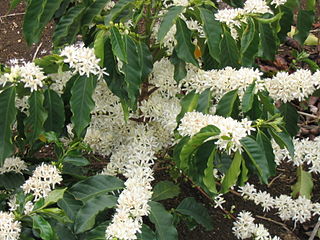
Coffea arabica, also known as the Arabian coffee, "coffee shrub of Arabia", "mountain coffee", or "arabica coffee", is a species of Coffea. Indigenous to Yemen, it is believed to be the first species of coffee to be cultivated, and is the dominant cultivar, representing some 60% of global production. Coffee produced from the less acidic, more bitter, and more highly caffeinated robusta bean makes up the preponderance of the remaining balance.
Kona coffee is the market name for coffee cultivated on the slopes of Hualalai and Mauna Loa in the North and South Kona Districts of the Big Island of Hawaii. It is one of the most expensive coffees in the world. Only coffee from the Kona Districts can be described as "Kona". The weather of sunny mornings, cloud or rain in the afternoon, little wind, and mild nights combined with porous, mineral-rich volcanic soil create favorable coffee growing conditions. The loanword for coffee in the Hawaiian language is kope, pronounced [ˈkope].

Coffea canephora, commonly known as robusta coffee, is a species of coffee that has its origins in central and western sub-Saharan Africa. It is a species of flowering plant in the Rubiaceae family. Though widely known as Coffea robusta, the plant is scientifically identified as Coffea canephora, which has two main varieties, robusta and nganda.

The history of coffee dates back to the 15th century, and possibly earlier with a number of reports and legends surrounding its first use. The native (undomesticated) origin of coffee is thought to have been Ethiopia, with several mythical accounts but no solid evidence. The earliest substantiated evidence of either coffee drinking or knowledge of the coffee tree is from the early 15th century, in the Sufi monasteries of Yemen, spreading soon to Mecca and Cairo. By the 16th century, it had reached the rest of the Middle East, South India (Coorg), Persia, Turkey, the Horn of Africa, and northern Africa. Coffee then spread to the Balkans, Italy, and to the rest of Europe, as well as Southeast Asia and then to America, despite bans imposed during the 15th century by religious leaders in Mecca and Cairo, and later by the Catholic Church.

Kapeng barako, also known as Barako coffee or Batangas coffee, is a coffee varietal grown in the Philippines, particularly in the provinces of Batangas and Cavite. It belongs to the species Coffea liberica. The term is also used to refer to all coffee coming from those provinces. Barako in the languages of the Philippines means "stud", and is associated with the image of masculinity. Barako has a strong flavor and fragrance reminiscent of aniseed.
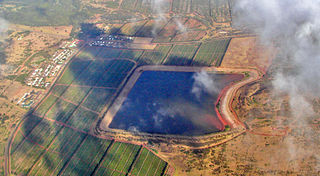
Moloka‘i Coffee refers to coffee grown, processed and roasted on the island of Moloka'i in Maui County, Hawaiʻi, United States.
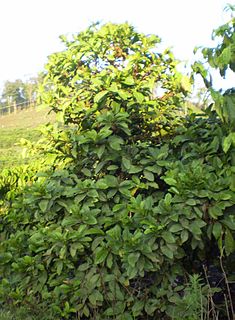
Coffea liberica is a species of flowering plant in the Rubiaceae family from which coffee is produced. It is native to western and central Africa from Liberia to Uganda and Angola, and has become naturalized in the Philippines, Indonesia, Seychelles, the Andaman & Nicobar Islands, French Polynesia, Central America, the West Indies, Venezuela, Colombia, Malaysia and Brazil.
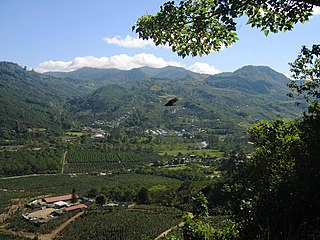
Coffee production has played a key role in Costa Rica's history and continues to be important to the country's economy. In 2006, coffee was Costa Rica's number three export, after being the number one cash crop export for several decades. In 1997, the agriculture sector employed 28 percent of the labor force and comprised 20 percent of Costa Rica's total GNP. Production increased from 158,000 tons in 1988 to 168,000 tons in 1992. The largest growing areas are in the provinces of San José, Alajuela, Heredia, Puntarenas, and Cartago. The coffee is exported to other countries in the world and is also exported to cities in Costa Rica.

Indonesia was the fourth-largest producer of coffee in the world in 2014. Coffee cultivation in Indonesia began in the late 1600s and early 1700s, in the early Dutch colonial period, and has played an important part in the growth of the country. Indonesia is geographically and climatologically well-suited for coffee plantations, near the equator and with numerous interior mountainous regions on its main islands, creating well-suited microclimates for the growth and production of coffee.

Coffee production in India is dominated in the hill tracts of South Indian states, with Karnataka accounting for 71%, followed by Kerala with 21% and Tamil Nadu. Indian coffee is said to be the finest coffee grown in the shade rather than direct sunlight anywhere in the world. There are about 250,000 coffee growers in the country; 98% of them are small growers. As of 2009, Indian coffee made up just 4.5% of the global production. Almost 80% of Indian coffee is exported; 70% is bound for Germany, Russia, Spain, Belgium, Slovenia, United States, Japan, Greece, Netherlands and France. Italy accounts for 29% of the exports. Most of the export is shipped through the Suez Canal.

Laos produces two main types of coffee: Robusta and Arabica. Robusta is mainly used for regular coffee as well as a typical coffee drink in Laos where it is sweetened with condensed milk. The latter, Arabica, is of a higher quality due to its mild taste, and it is used for espresso. For the 20,000 tons of coffee that Laos produces a year, 5,000 tons are Arabica beans and 15,000 tons are Robusta.
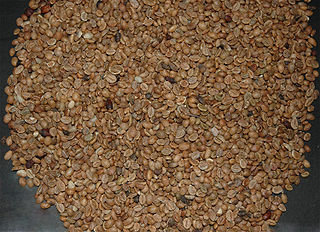
Robusta coffee is coffee made from the Coffea canephora plant, a sturdy species of coffee bean with low acidity and high bitterness. C. canephora beans, widely known by the synonym Coffea robusta, are used primarily in instant coffee, espresso, and as a filler in ground coffee blends.
Coffee production in Panama was occurring in the Boquete Valley by the early 20th century, although coffee was growing wild all over the Pacific coast region of Panama by this time, when production did not match domestic consumption. The International Coffee Organization (ICO) has grouped mild arabica as the variety of coffee that is grown in Panama. The best quality of coffee in Panama is grown in Boquete. In the Coffee Review of 2008, two Panamanian coffees have received higher rating and fetched record prices than the coffee from Costa Rica.
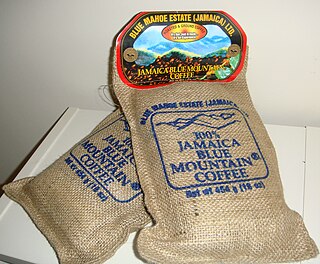
Coffee production in Jamaica began after 1728, when governor Sir Nicholas Lawes introduced the crop near Castleton, north of Kingston. Jamaican Blue Mountain Coffee is the special variety of coffee that is grown in the Blue Mountains region, which has the most conducive climate and topographical features; this variety is known for its scent and sweet taste. Most of Jamaica's coffee production is grown for export.

Thailand is one of the top coffee producers in the world as of 2014. The country is ranked third among the coffee producing countries of Asia with robusta coffee accounting for 99 percent of its production.
Benguet coffee, also known as Benguet arabica, is a single-origin coffee varietal grown in the Cordillera highlands of the northern Philippines since the 19th century. It belongs to the species Coffea arabica, of the Typica variety. It is one of the main crops of farmers in the province of Benguet, which has a climate highly suitable for arabica cultivation. Benguet coffee is listed in the Ark of Taste international catalogue of endangered heritage foods by the Slow Food movement.
Sagada coffee, also known as Sagada arabica or SGD coffee, is a single-origin coffee varietal grown in Sagada in the Cordillera highlands of the northern Philippines. It belongs to the species Coffea arabica, of the Typica variety.



